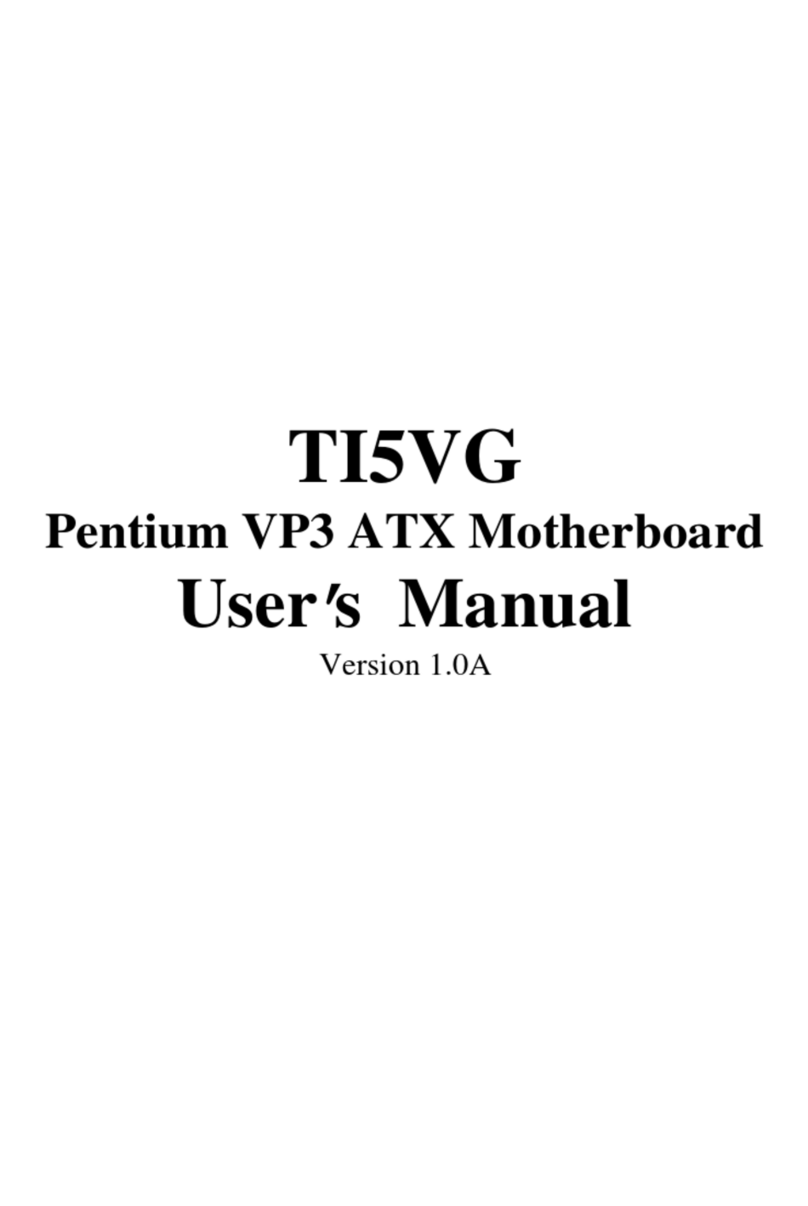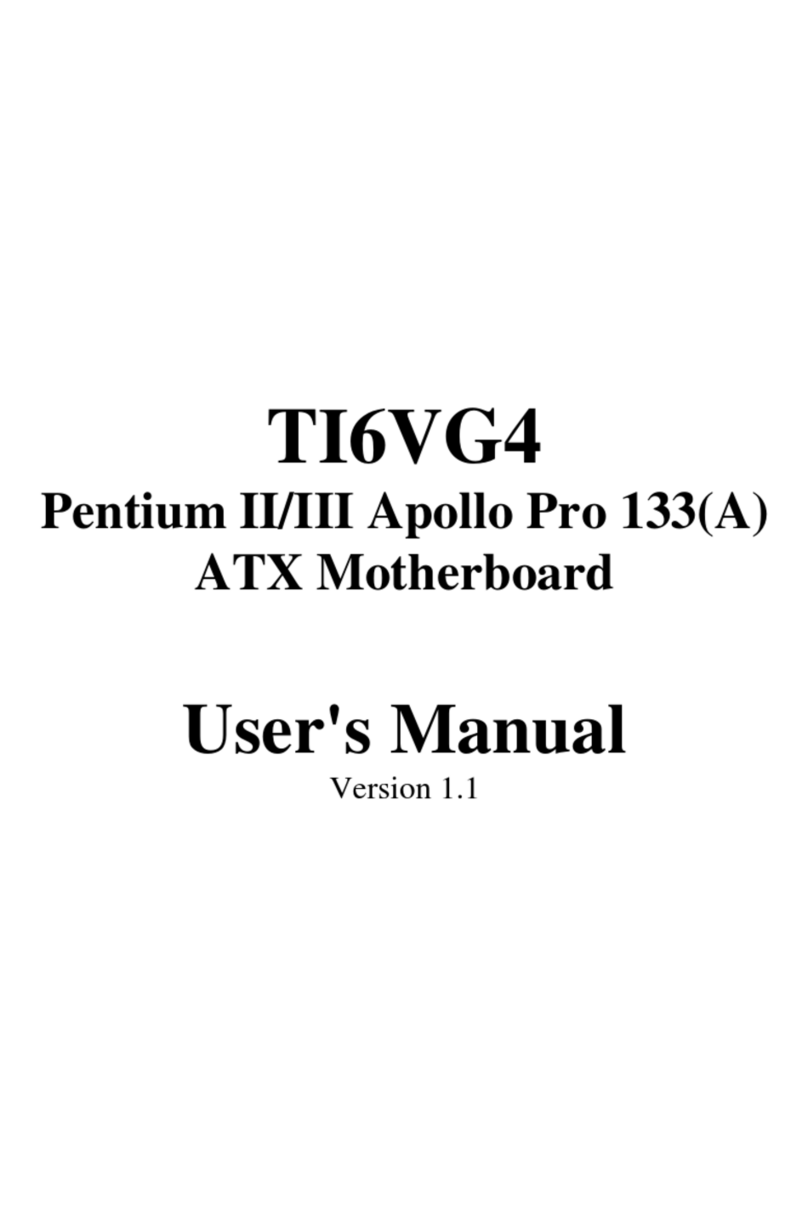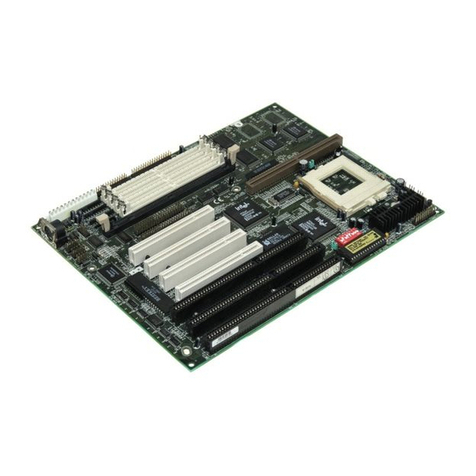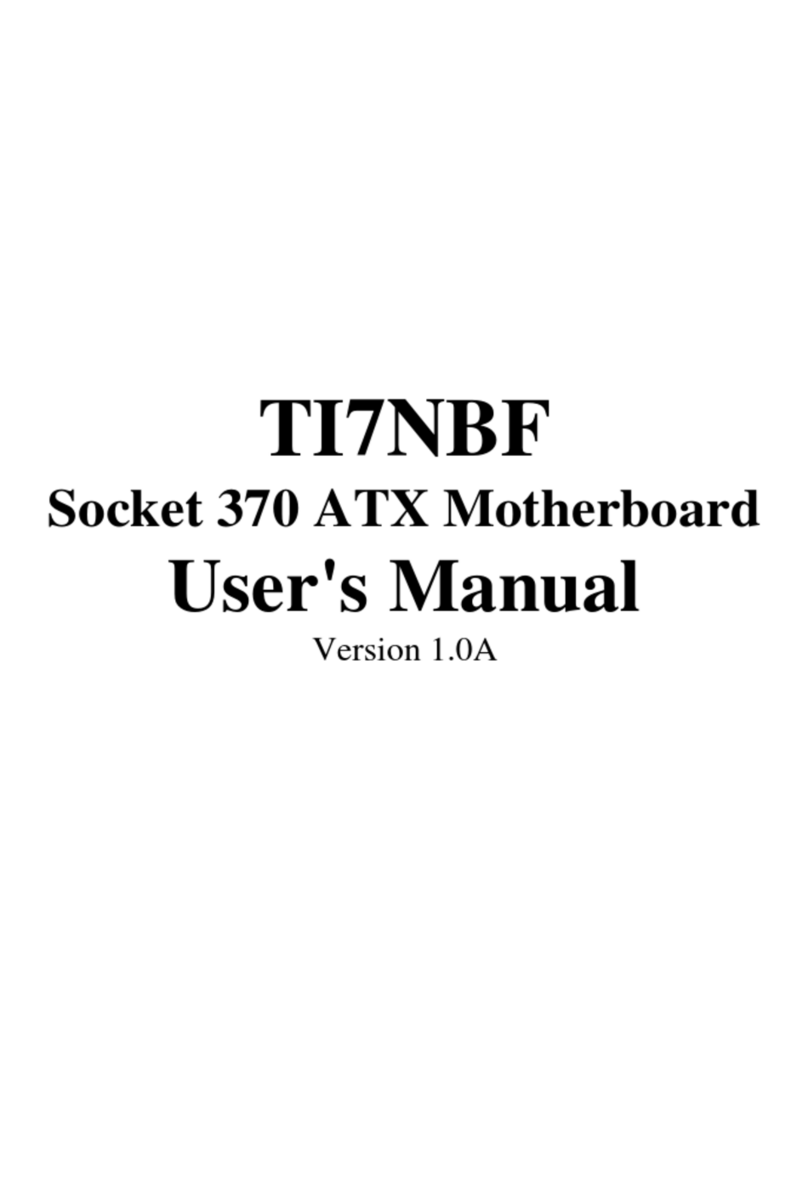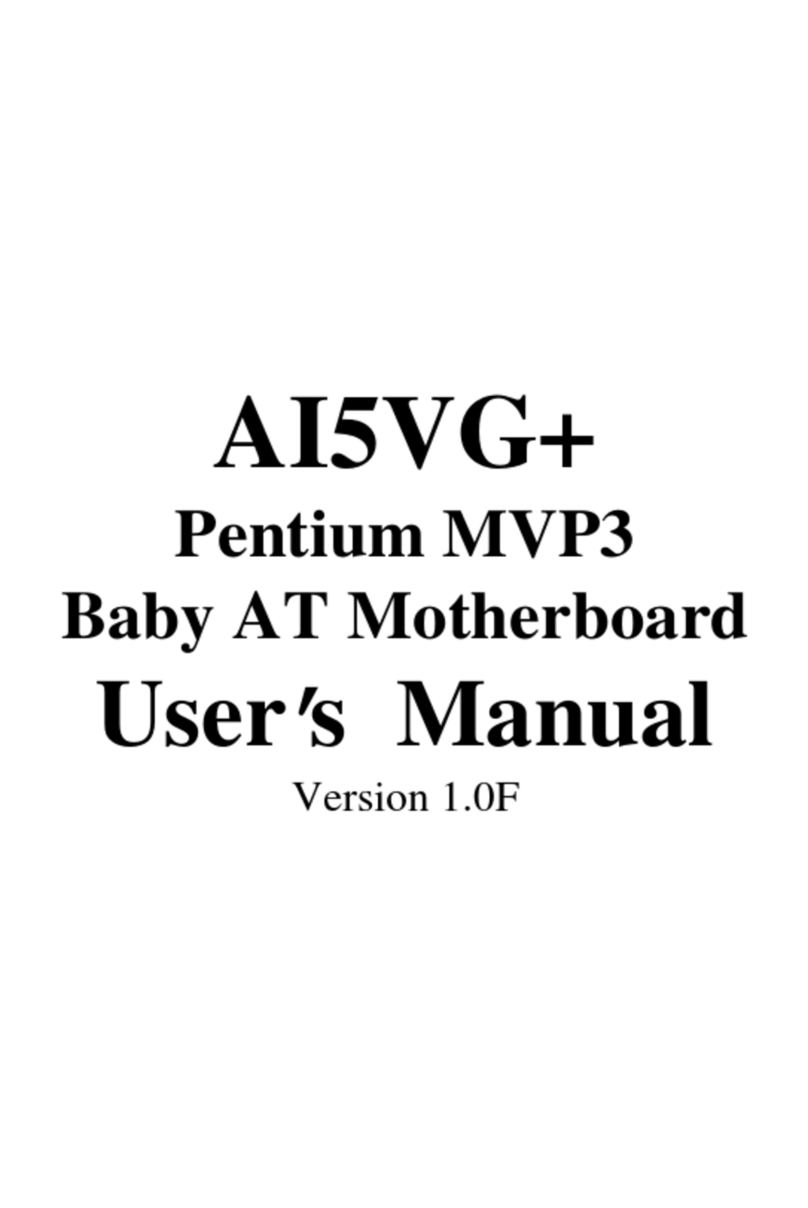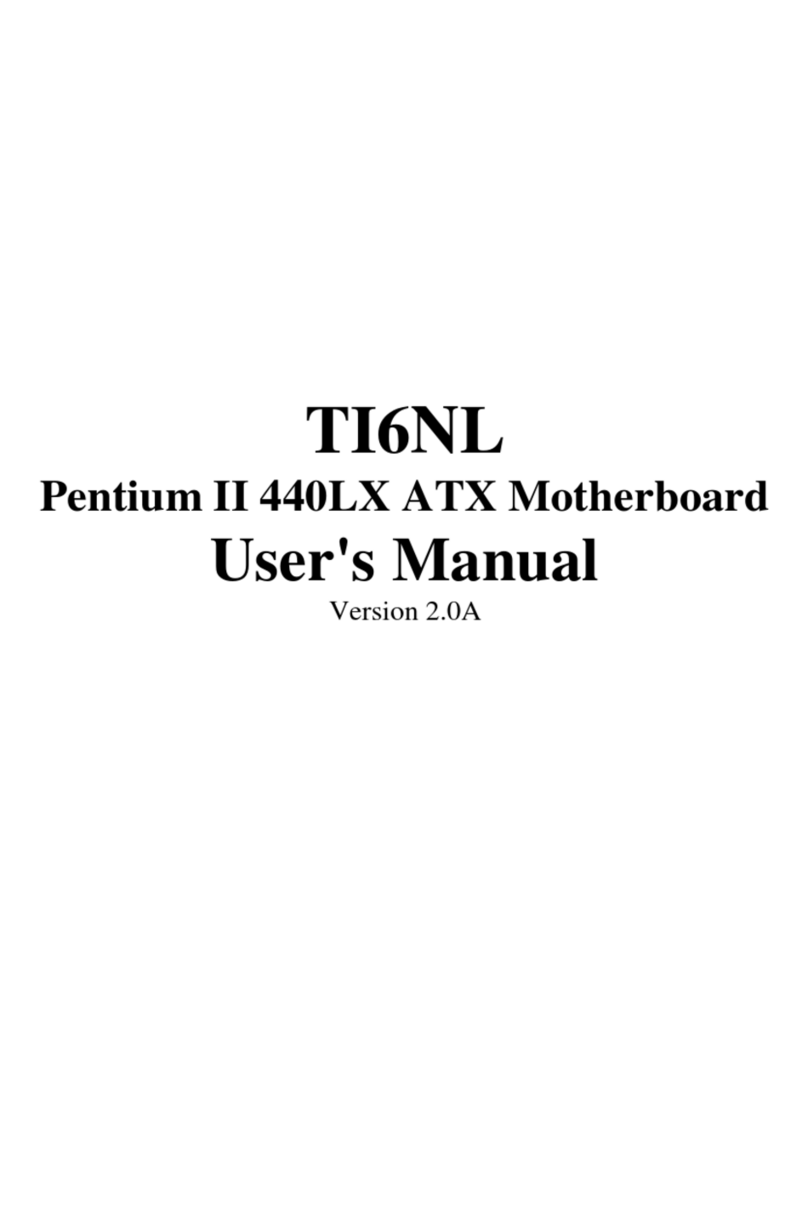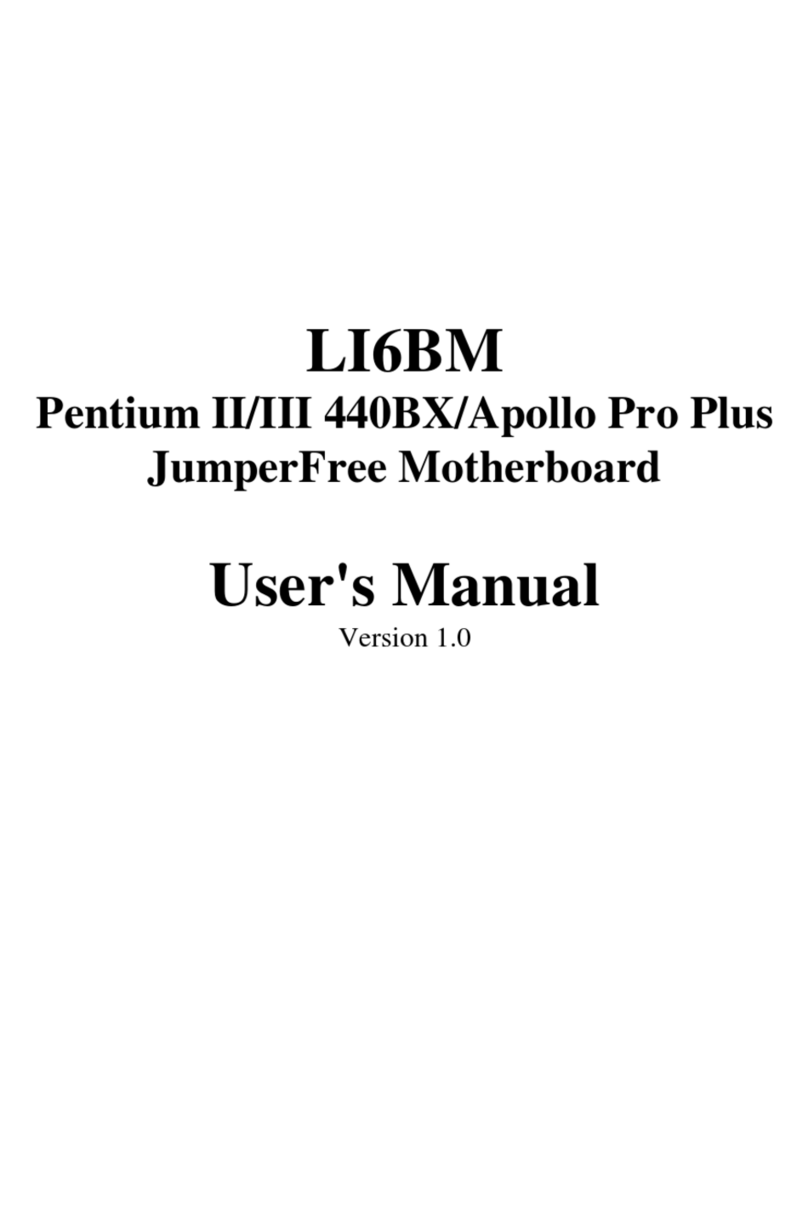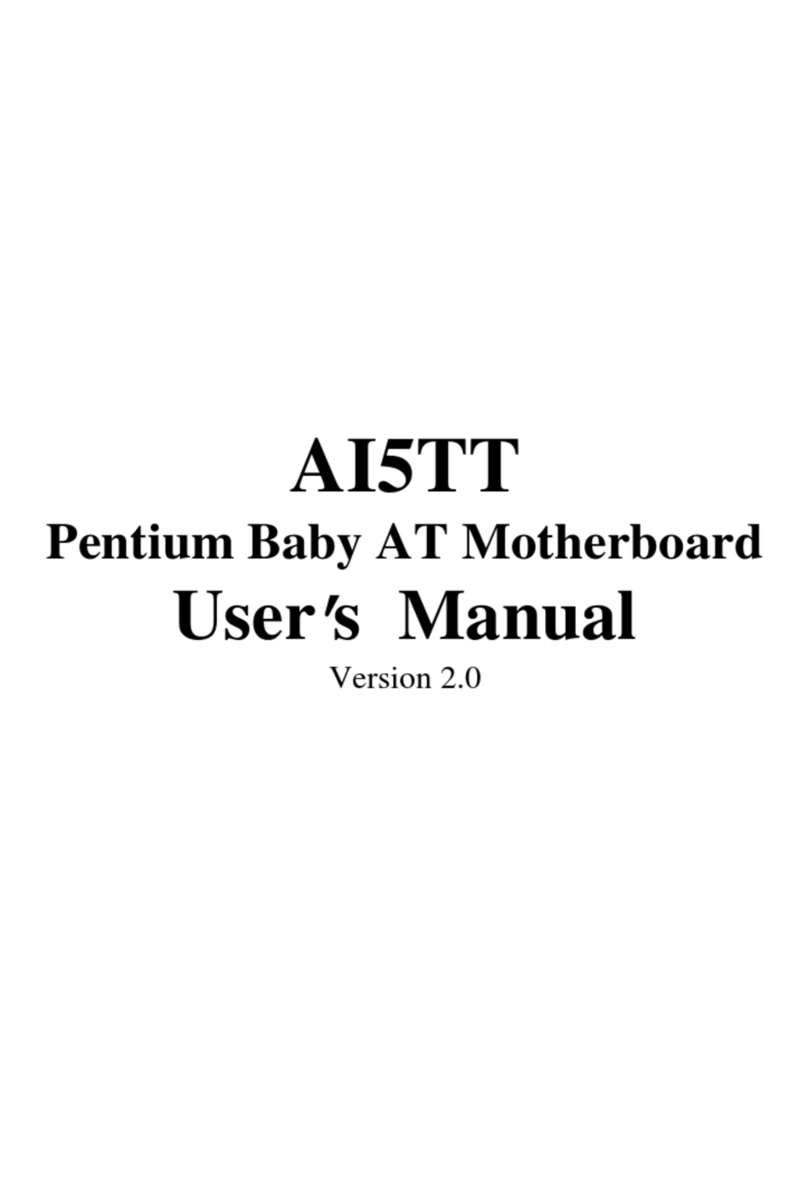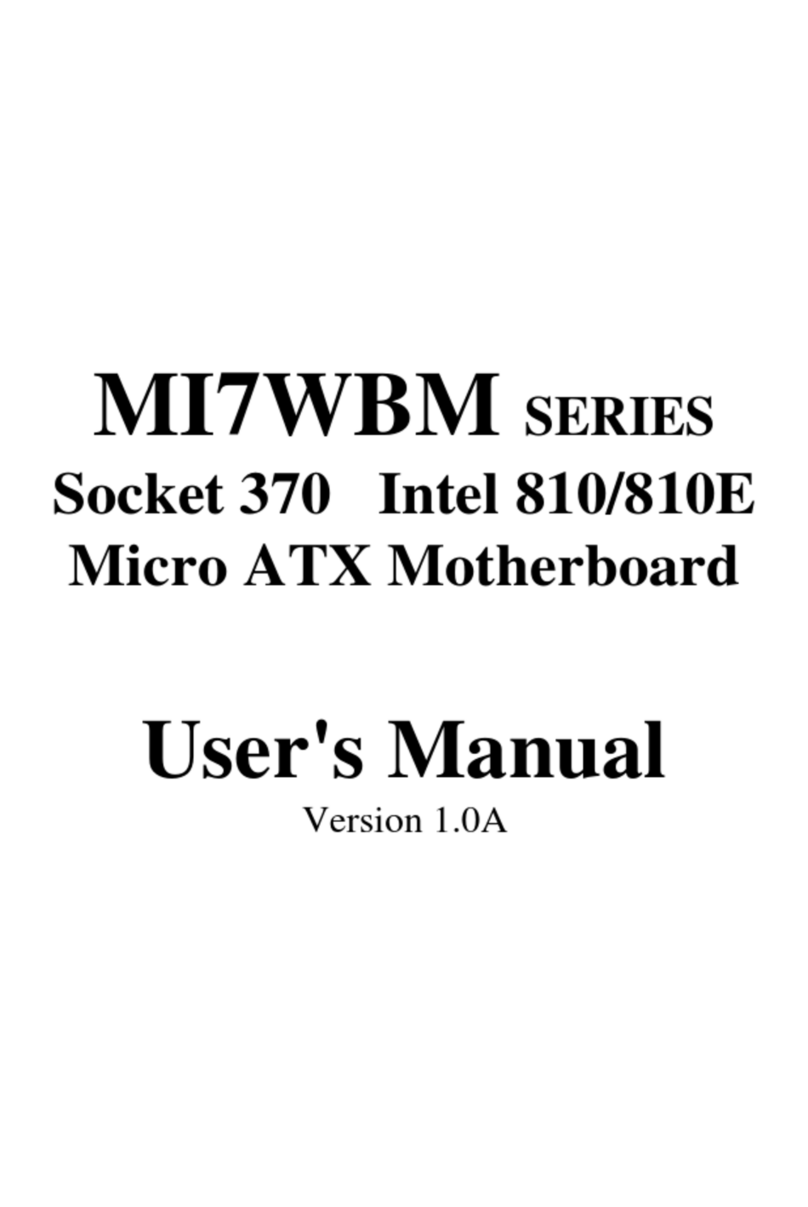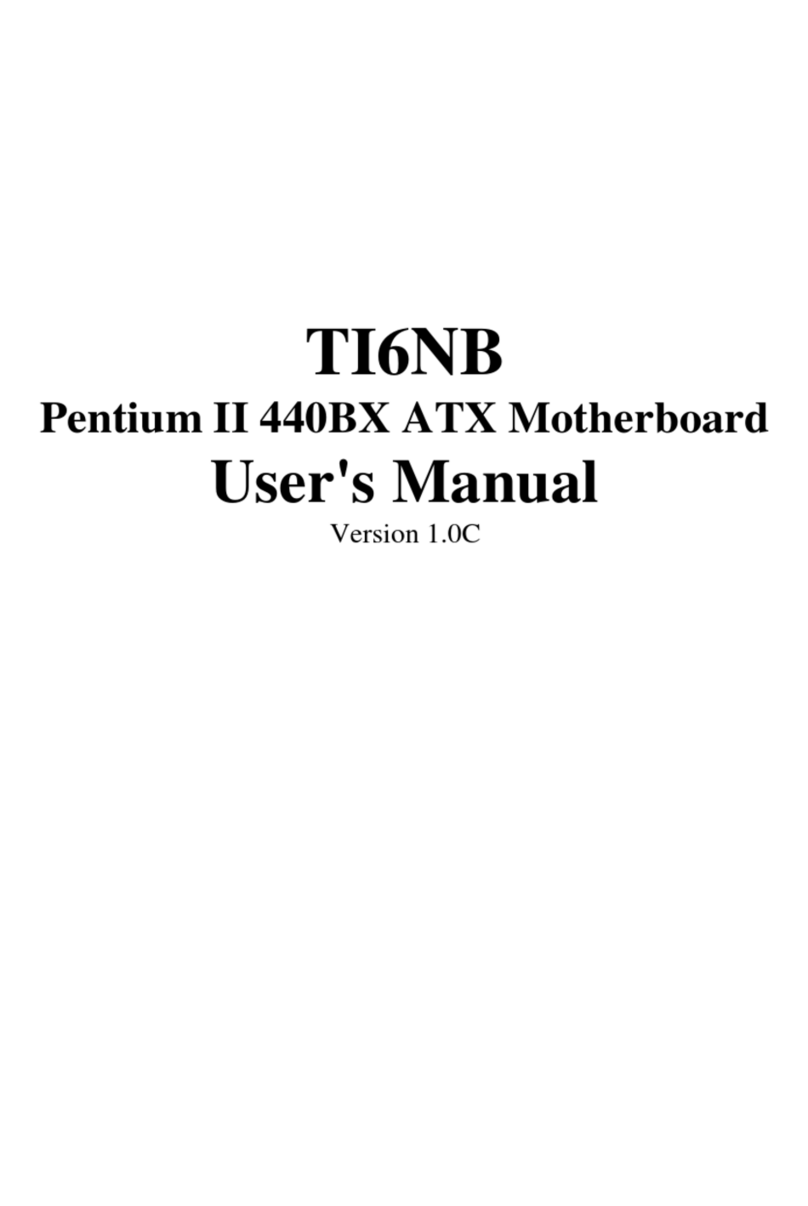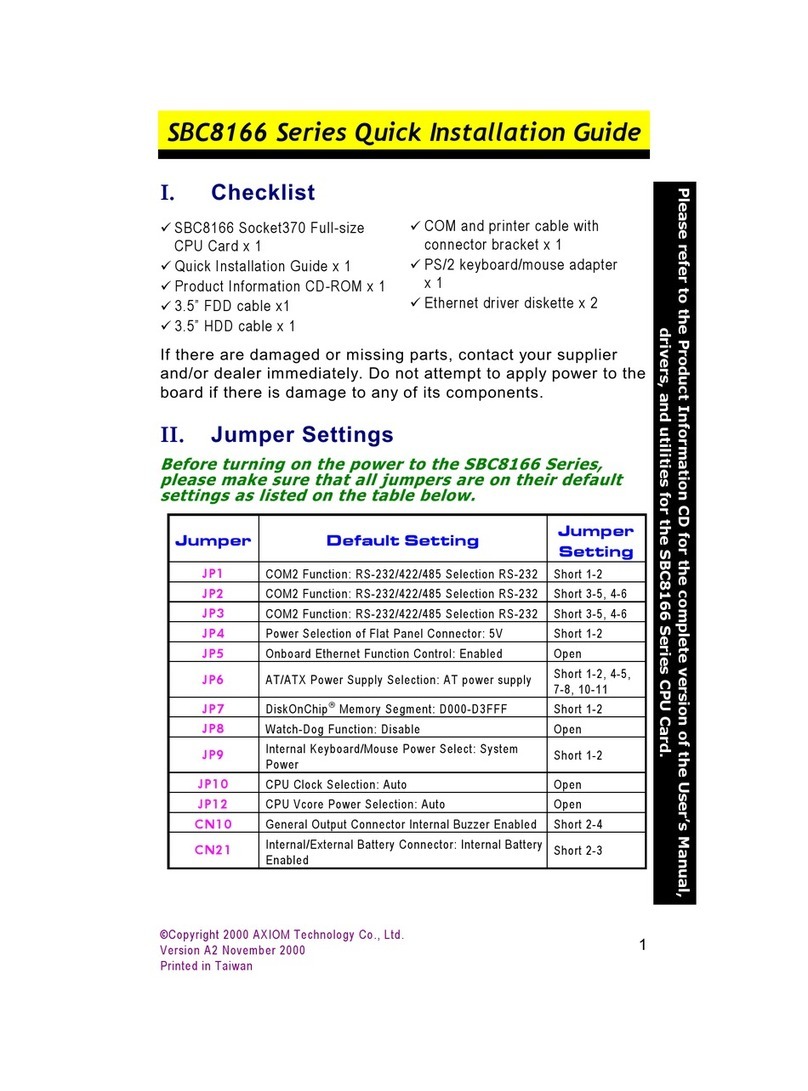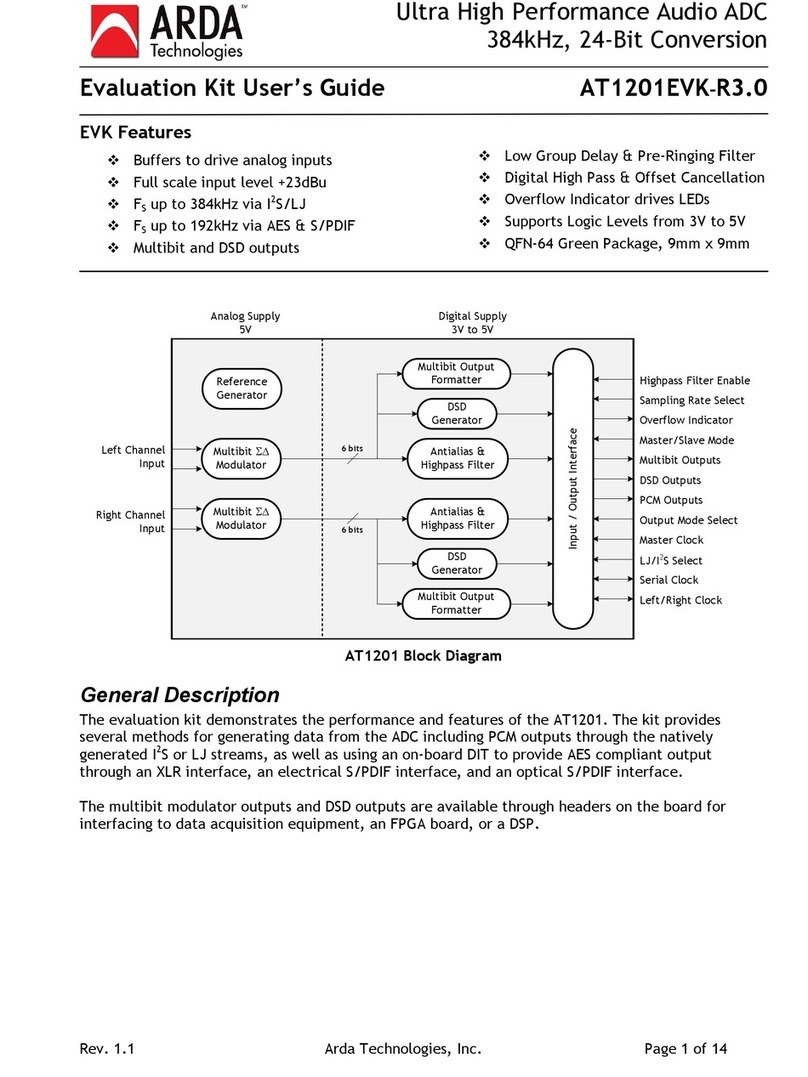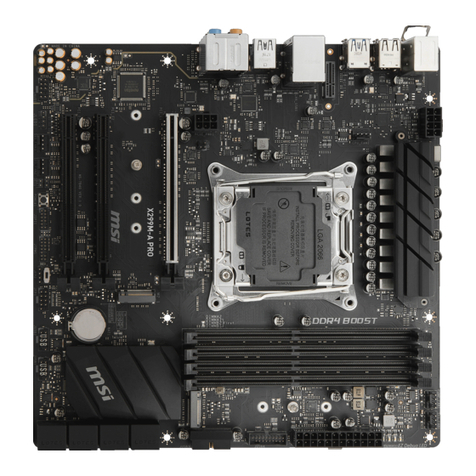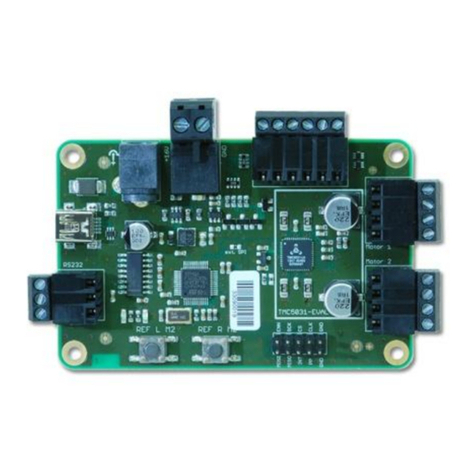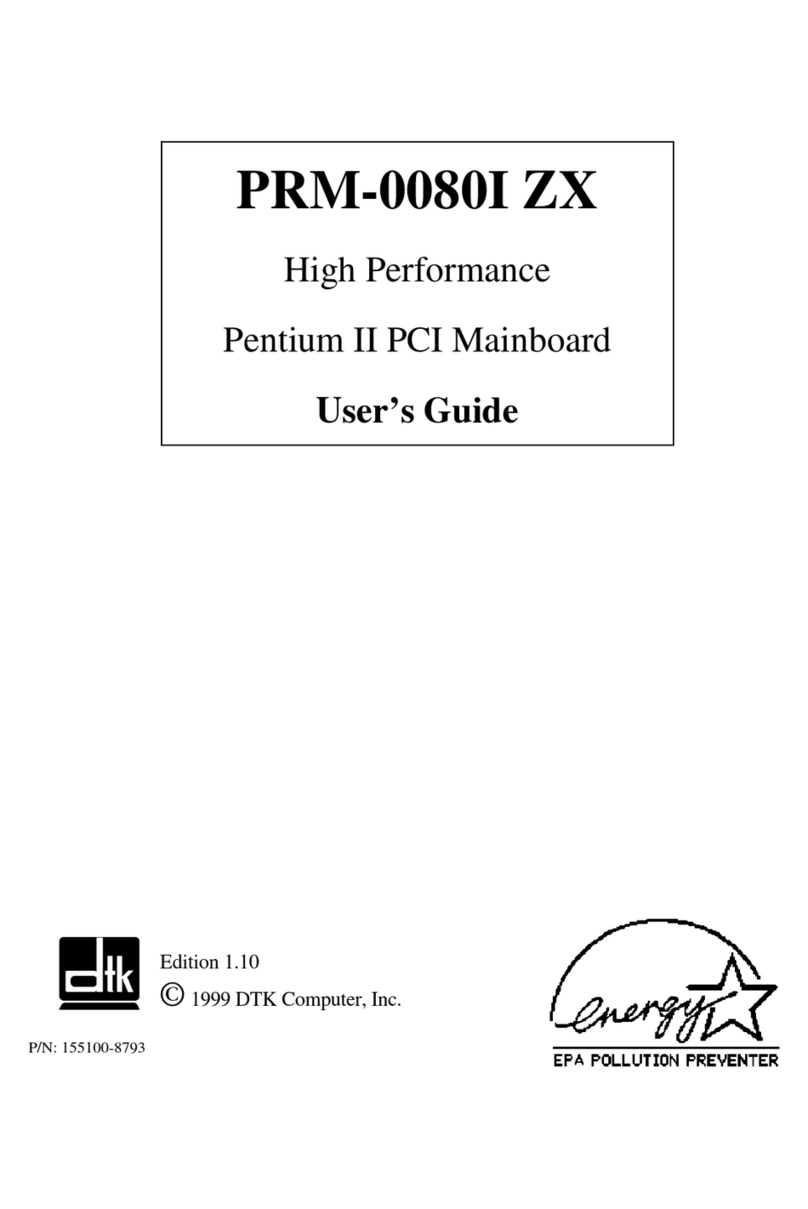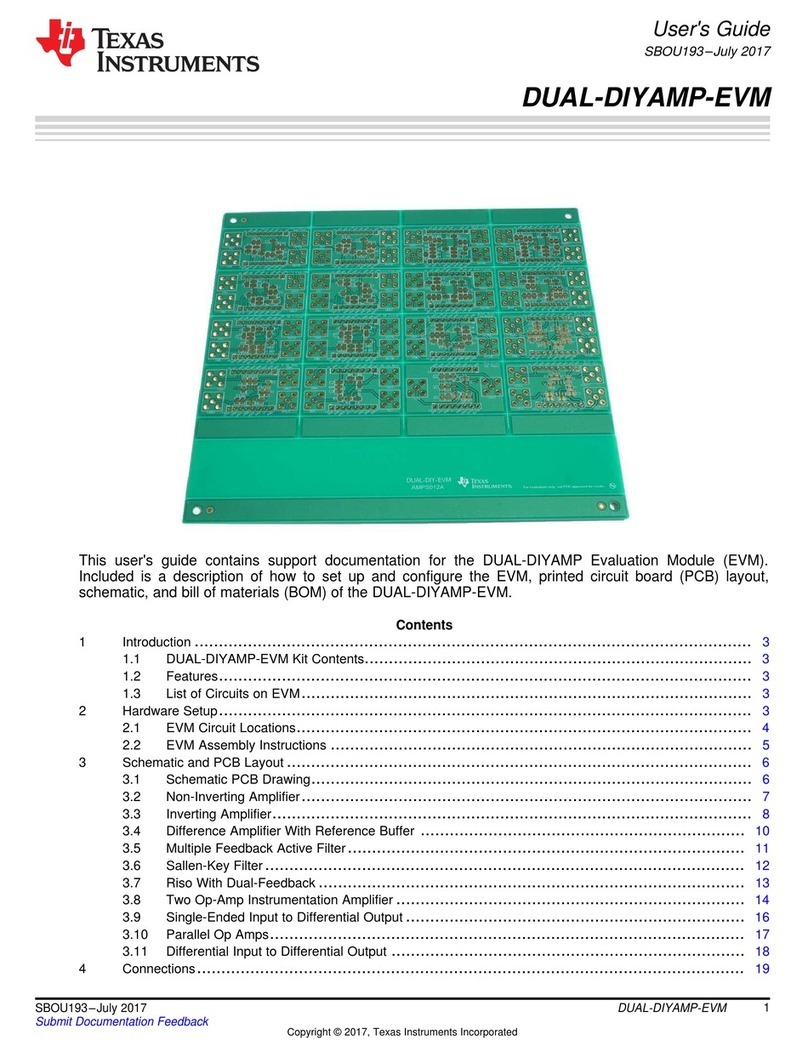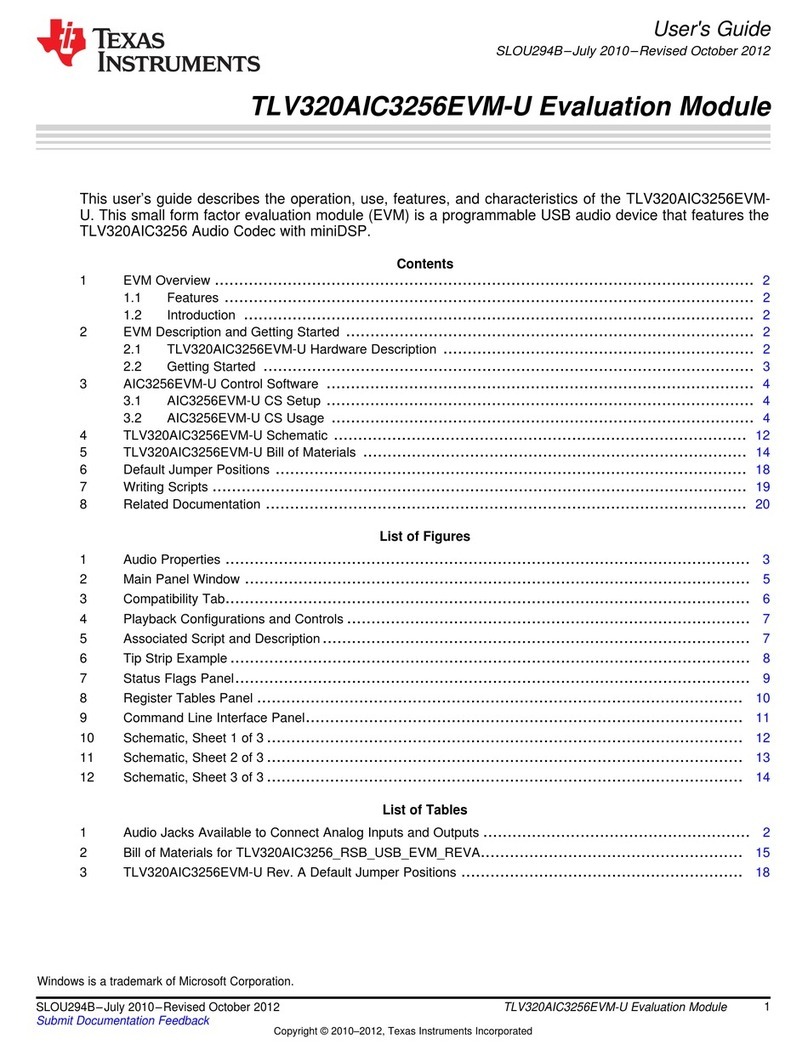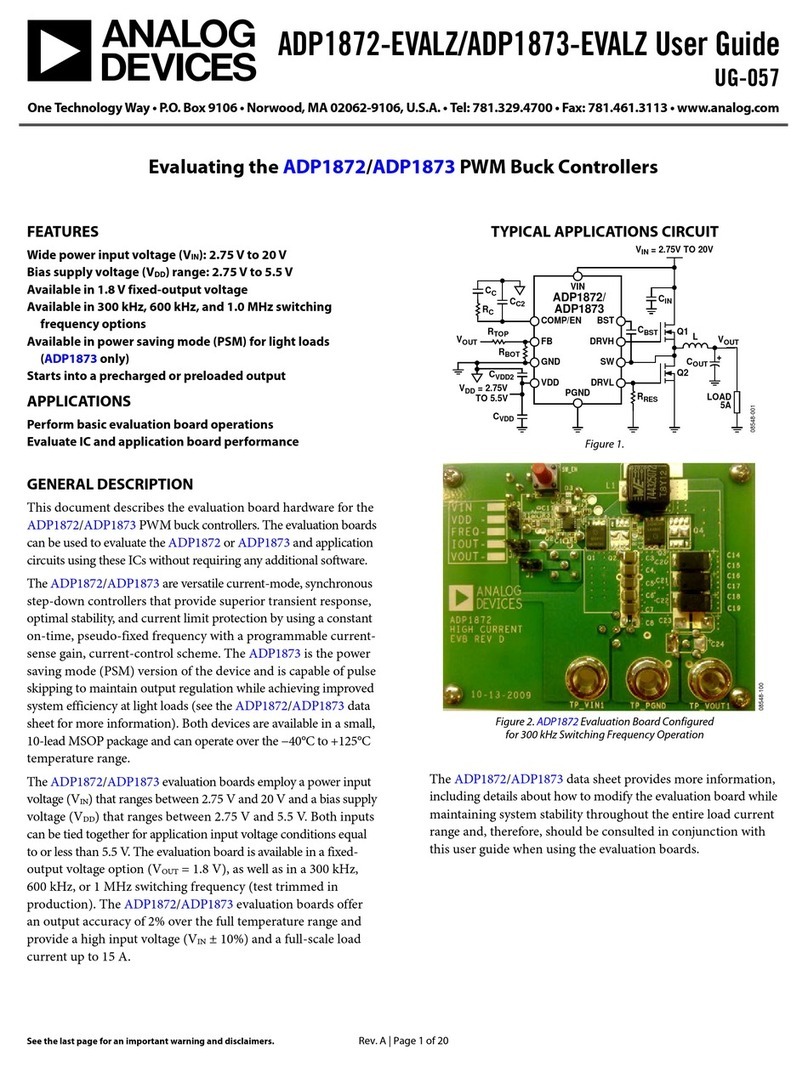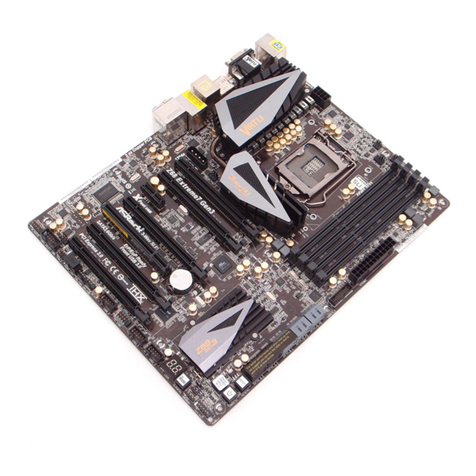TMC TI5VGA User manual

TI5VGA
Socket 7 MVP3
ATX Motherboard
User’s Manual
Version 1.0A


Contents
TI5VGA Socket 7 MVP3 ATX Motherboard User’s Manual i
Contents
Chapter 1 Introduction....................................................1
Chapter 2 Specifications..................................................2
Chapter 3 Hardware Description ...................................5
3.1 Processor and CPU Voltage ..............................................7
3.2 L2 Cache Memory.............................................................7
3.3 Main Memory....................................................................7
3.4 BIOS..................................................................................9
3.5 Onboard PCI EIDE............................................................9
3.6 Onboard Multi-I/O.............................................................9
3.7 Onboard Hardware Monitoring.......................................10
3.8 I/O Port Address Map......................................................10
3.9 DMA Channels................................................................11
3.10 Interrupt Request Lines (IRQ).......................................11
3.11 Accelerated Graphics Port (AGP) Slot..........................11
Chapter 4 Hardware Settings........................................13
4.1 SW1(1-8): CPU Frequency Selector ...............................15
4.2 JP1: DRAM Operating Frequency......................................18
4.3 JP3, SW2(1-4): CPU VCORE Voltage Selector...............18
4.4 JP5: Clear CMOS Selection ............................................20
Chapter 5 Installation....................................................21
5.1 I/O Connectors.................................................................23
5.2 J1: PS/2 Keyboard and PS/2 Mouse Connectors.............23
5.3 J2, J19: USB Connectors.................................................24
5.4 J3, J4 Serial Ports ............................................................24
5.5 J5: Parallel Port Connector..............................................25
5.6 J9, J6, J7, J8: Game Port, Mic In/Line In/Line Out ........25
5.7 J10: ATX Power Supply Connector................................26
5.8 J11: CPU Fan Power Connector......................................26
5.9 J12: Floppy Drive Connector ..........................................27
5.10 J13, J14: CD In Connectors..........................................27
5.11 IDE1, IDE2: EIDE Connectors......................................28

Contents
ii TI5VGA Socket 7 MVP3 ATX Motherboard User’s Manual
5.12 J16: AGP Fan Power Connector....................................29
5.13 J17: IrDA Connector .....................................................29
5.14 J18 Wake on LAN Connector .......................................29
5.15 J20: Chassis Fan Power Connector ...............................29
5.16 J21 Front Bezel Connector............................................30
Chapter 6 BIOS Configuration.....................................33
6.1 BIOS Introduction ...........................................................36
6.2 BIOS Setup......................................................................36
6.3 Standard CMOS Setup.....................................................38
6.4 BIOS Features Setup .......................................................41
6.5 Chipset Features Setup....................................................44
6.6 Power Management Setup...............................................47
6.7 PNP/PCI Configuration...................................................50
6.8 Load BIOS Defaults ........................................................52
6.9 Load Setup Defaults ........................................................52
6.10 CPU Features Setup.......................................................53
6.11 Integrated Peripherals....................................................54
6.12 Supervisor / User Password...........................................56
6.13 IDE HDD Auto Detection .............................................57
6.14 Save & Exit Setup..........................................................58
6.15 Exit Without Saving......................................................58
Chapter 7 VIA Drivers and DirectX Installation.........59
7.1 Windows 95 4-in-1 Driver Installation............................59
7.2 Windows 95 Audio Driver Installation ...........................64
7.3 Windows 98 4-in-1 Driver Installation............................65
7.4 Windows 98/95 DirectX Installation...............................68
7.5 Windows 98 Audio Driver Installation ...........................70
7.6 Windows 98SE 4-in-1 Driver Installation.......................71
7.7 Windows 98SE Audio Driver Installation.......................73
7.8 Windows NT 4.0 Audio Driver Installation....................74
Chapter 8 System Monitor Installation........................79
Appendix..........................................................................82
A. Additions & Errata............................................................82

Chapter 1 Introduction
TI5VGA Socket 7 MVP3 ATX Motherboard User’s Manual 1
Chapter 1 Introduction
This manual is designed to give you information on the TI5VGA
Motherboard. It is divided into the following six sections:
•
••
•
Introduction
•
••
•
Specifications
•
••
•
Hardware Description
•
••
•
Hardware Settings
•
••
•
Installation
•
••
•
BIOS Configuration
Checklist
Please check that your package is complete and contains the items below.
If you discover damaged or missing items, please contact your dealer.
The TI5VGA Motherboard
This user’s manual
1 IDE ribbon cable
1 floppy ribbon cable
1 UDMA66 ribbon cable (optional)
1 CD containing Bus Master IDE drivers, flash utility, and
other drivers
Note: The ATA-66 IDE cable that is used in conjunction with Ultra
DMA/66 hard disks is optional. Refer to the figure below on how to
connect the cable.

Chapter 2 Specifications
2 TI5VGA Socket 7 VP3/MVP3 ATX Motherboard User’s Manual
Chapter 2 Specifications
Based on VIA’s MVP3 chipset, the TI5VGA is an ATX Socket 7
motherboard that supports all the features to make a Microsoft PC’97
compliant PCI system.
The TI5VGA comes with an Accelerated Graphics Port (AGP) slot,
power management functionality that is compliant with ACPI
(Advanced Configuration and Power Interface) and legacy APM
requirements. In addition to standard PIO and DMA mode operation, it
features Ultra DMA33/66 for improved disk I/O throughput. The main
features of this motherboard are listed as follows:
Main Processor
Intel Pentium 100/133/150/166/200
Intel Pentium MMX (P55C) 100/133/166/200/233
Cyrix 6x86/6x86L P166+/P200+
Cyrix 6x86MX PR166/PR200/PR233/PR266
Cyrix 6x86MII PR266/PR300/PR333/PR366
AMD K5 PR100/PR133/PR166
AMD K6 166/200/233/266/300
AMD K6-2/300/333/350/366/380/400/450
IDT WinChip C6 180/200/225MHz
IDT WinChip2-3D 200/225/266MHz
L2 Cache
1MB Pipelined Burst Synchronous SRAM onboard, 2MB optional
Main Memory
Three 168-pin DIMM sockets
DIMMs: EDO DRAM or SDRAM (Synchronous DRAM)
DIMM Size: 8MB, 16MB, 32MB, 64MB, 128MB
Chipset
VIA chipset (VT82C598MVP, VT82C686A)
[
Onboard I/O
VIA VT82C686A chip supports two serial, one parallel, one floppy
drive interface and IrDA support

Chapter 2 Specifications
TI5VGA Socket 7 MVP3 ATX Motherboard User’s Manual 3
Onboard Bus Mastering EIDE
Two EIDE interfaces for up to four devices, support PIO Mode 3/4
or Ultra DMA33/66 IDE Hard Disk and ATAPI CD-ROM.
NOTE: A UDMA66 cable should be used for UDMA66 interface.
Under Windows NT 4.0, you need to install Windows NT Service
Pack 4.)
BIOS
Licensed BIOS with additional features:
• FLASH EEPROM (128KB) for BIOS update
• ISA Plug and Play (PnP) extension
• Power management
Hardware Monitoring IC
VT82C686A includes the hardware monitoring feature that
monitors the system temperature, voltages and fan speed. With the
use of a system management utility, the hardware status can be
checked and warning message can be displayed when there is a
problem.
Windows 95/98 Shut-Down
This allows the PC to power off via Windows 95/98 operating
system.
PC97 Compliance
The TI5VGA implements BIOS and hardware designs that meet
PC97 standards and is fully compatible with all Windows operating
systems.
Year 2000 Compliant BIOS
The onboard Award BIOS is Year 2000 Compliant and will pass
software applications that have the tendency to invoke INT1AH
function 04H such as year2000.exe utility released by NSTL.
Expansion Slots
Six 32-bit PCI master slots
One AGP slot (Accelerated Graphics Port)
Form Factor
ATX, 12”x 7.48” (30.5cm x 19cm)

Chapter 2 Specifications
4 TI5VGA Socket 7 MVP3 ATX Motherboard User’s Manual
This page is intentionally left blank.

Chapter 3 Hardware Description
TI5VGA Socket 7 MVP3 ATX Motherboard User’s Manual 5
Chapter 3 Hardware Description
This chapter briefly describes each of the major features of the TI5VGA
motherboard. The layout of the board is shown in Figure 1 which shows
the locations of the key components. The topics covered in this chapter
are as follows:
3.1 Processor and CPU Voltage........................................................7
3.2 L2 Cache Memory.......................................................................7
3.3 Main Memory..............................................................................7
3.4 BIOS ...........................................................................................9
3.5 Onboard PCI EIDE.....................................................................9
3.6 Onboard Multi-I/O......................................................................9
3.7 Onboard Hardware Monitoring.................................................10
3.8 I/O Port Address Map...............................................................10
3.9 DMA Channels..........................................................................11
3.10 Interrupt Request Lines (IRQ).................................................11
3.11 Accelerated Graphics Port (AGP) Slot....................................11

Chapter 3 Hardware Description
6 TI5VGA Socket 7 MVP3 ATX Motherboard User’s Manual
Figure 1: Layout of the TI5VGA Motherboard

Chapter 3 Hardware Description
TI5VGA Socket 7 MVP3 ATX Motherboard User’s Manual 7
3.1 Processor and CPU Voltage
The TI5VGA is designed to take a Socket 7-based processor with a bus
speed of 66, 75, 83 and 100 MHz. The internal clock of the CPU can be
multiples of 1.5, 2, 2.5, 3, 3.5, 4, 4.5, 5 and 5.5 of the bus clock, the CPU
frequency can be 100 to 550MHz.
The onboard CPU voltage regulator provides support for CPUs Vcore
which require voltage other than 3.3V such as 2.8V, and/or power
consumption higher than 10 watts.
3.2 L2 Cache Memory
The TI5VGA supports 1MB P.B. (Pipelined Burst) Synchronous Cache.
2MB is optional. The P.B. Synchronous Cache boosts the system’s
performance, 10% higher than regular Asynchronous Cache.
3.3 Main Memory
The TI5VGA motherboard supports three 168-pin DIMMs (Dual In-line
Memory Module) sockets. DIMM modules can be 8MB, 16MB, 32MB,
64MB and 128MB in EDO DRAM or SDRAM type. DIMM1, DIMM2
or DIMM3 bank can be populated first. Examples are shown in the
following table on how to configure the memory size.
168-pin DIMM (3.3V) – SDRAM or EDO DRAM
Bank0
(DIMM3) Bank1
(DIMM2) Bank2
(DIMM1) Total Memory
8MB ----- ----- 8MB
16MB ----- ----- 16MB
32MB ----- ----- 32MB
64MB ----- ----- 64MB
128MB ----- ----- 128MB
8MB 8MB ----- 16MB
16MB 8MB ----- 24MB
32MB 8MB ----- 40MB
64MB 8MB ----- 72MB
128MB 8MB ----- 136MB
8MB 8MB 8MB 24MB
16MB 8MB 8MB 32MB
32MB 8MB 8MB 48MB
64MB 8MB 8MB 80MB

Chapter 3 Hardware Description
8 TI5VGA Socket 7 MVP3 ATX Motherboard User’s Manual
168-pin DIMM (3.3V) – SDRAM or EDO DRAM
Bank0
(DIMM3) Bank1
(DIMM2) Bank2
(DIMM1) Total Memory
128MB 8MB 8MB 144MB
16MB 16MB ----- 32MB
32MB 16MB ----- 48MB
64MB 16MB ----- 80MB
128MB 16MB ----- 144MB
16MB 16MB 8MB 40MB
32MB 16MB 8MB 56MB
64MB 16MB 8MB 88MB
128MB 16MB 8MB 152MB
16MB 16MB 16MB 48MB
32MB 16MB 16MB 64MB
64MB 16MB 16MB 96MB
128MB 16MB 16MB 160MB
32MB 32MB ----- 64MB
64MB 32MB ----- 96MB
128MB 32MB ----- 160MB
32MB 32MB 8MB 72MB
64MB 32MB 8MB 104MB
128MB 32MB 8MB 168MB
32MB 32MB 16MB 80MB
64MB 32MB 16MB 112MB
128MB 32MB 16MB 176MB
32MB 32MB 32MB 96MB
64MB 32MB 32MB 128MB
128MB 32MB 32MB 192MB
64MB 64MB ----- 128MB
128MB 64MB ----- 192MB
64MB 64MB 8MB 136MB
128MB 64MB 8MB 200MB
64MB 64MB 16MB 144MB
128MB 64MB 16MB 208MB
64MB 64MB 32MB 160MB
128MB 64MB 32MB 224MB
64MB 64MB 64MB 192MB
128MB 64MB 64MB 256MB
128MB 128MB 128MB 384MB

Chapter 3 Hardware Description
TI5VGA Socket 7 MVP3 ATX Motherboard User’s Manual 9
3.4 BIOS
The BIOS on the TI5VGA motherboard provides the standard BIOS
functions plus the following additional features:
1. DMI (Desktop Management Interface)
The motherboard supports DMI to enable computer system management
in an enterprise.
2. ISA Plug and Play (PnP) Extension
Unlike PCI cards which are plug and play, ISA cards require setting
jumpers to resolve hardware conflicts. To make a computer system PnP,
an ISA PnP standard is established and supported by new OSes, such as
Windows 95. Under Windows 95, the motherboard BIOS must have ISA
PnP extension to support the new ISA PnP cards.
3. Power Management
The power management feature provides power savings by slowing down
the CPU clock, turning off the monitor screen and stopping the HDD
spindle motor.
3.5 Onboard PCI EIDE
The PCI EIDE controller is part of the VT82686A chipset. It supports
PIO mode 3/4 and bus mastering. The peak transfer rate of PIO mode 3/4
can be as high as 17MB/sec. Using HDDs that support bus mastering, the
peak transfer rate can reach 22MB/sec. There are two IDE connectors,
primary IDE and secondary IDE. With two devices per connector, up to
four IDE drives are supported. The VT82686A also supports UDMA33
and UDMA66, a new “synchronous DMA” protocol for faster data
transfers.
3.6 Onboard Multi-I/O
The multi-I/O is integrated in the VIA chipset that supports two 16550
UART-compatible serial ports, one high speed EPP/ECP parallel port
and one floppy controller. The floppy controller supports 2.88MB
format. The I/O port addresses of the serial and parallel ports are
programmable via BIOS set-up.

Chapter 3 Hardware Description
10 TI5VGA Socket 7 MVP3 ATX Motherboard User’s Manual
3.7 Onboard Hardware Monitoring
The hardware monitoring function is integrated in the VIA chipset. It
monitors the system temperature, voltages and fan speeds. With the use
of a system management utility, the hardware status can be checked and
warning message can be displayed when there is a problem.
3.8 I/O Port Address Map
Each peripheral device in the system is assigned a set of I/O port
addresses which also becomes the identityof the device. There are a total
of 1K port address space available. The following table lists the I/O port
addresses used on the motherboard.
Address Device Description
000h - 01Fh DMA Controller #1
020h - 03Fh Interrupt Controller #1
040h - 05Fh Timer
060h - 06Fh Keyboard Controller
070h - 07Fh Real Time Clock, NMI
080h - 09Fh DMA Page Register
0A0h - 0BFh Interrupt Controller #2
0C0h - 0DFh DMA Controller #2
0F0h Clear Math Coprocessor Busy Signal
0F1h Reset Math Coprocessor
1F0h - 1F7h IDE Interface
278 - 27F Parallel Port #2 (LPT2)
2F8h - 2FFh Serial Port #2 (COM2)
2B0 - 2DF Graphics adapter Controller
378h - 3FFh Parallel Port #1(LPT1)
360 - 36F Network Ports
3B0 - 3BF Monochrome & Printer adapter
3C0 - 3CF EGA adapter
3D0 - 3DF CGA adapter
3F0h - 3F7h Floppy Disk Controller
3F8h - 3FFh Serial Port #1 (COM1)

Chapter 3 Hardware Description
TI5VGA Socket 7 MVP3 ATX Motherboard User’s Manual 11
3.9 DMA Channels
There are seven DMA Channels available on the motherboard. Only
DMA2 is used by the floppy controller. In the case that ECP mode on the
parallel port is used, DMA1 or DMA3 will be used.
3.10 Interrupt Request Lines (IRQ)
There are a total of 15 IRQ linesavailable on the motherboard. Peripheral
devices use interrupt request lines to notify the CPU for the service
required. The following table shows the IRQ used by the devices on the
motherboard.
Level Function
IRQ0 System Timer Output
IRQ1 Keyboard
IRQ2 Interrupt Cascade
IRQ3 Serial Port #2
IRQ4 Serial Port #1
IRQ5 Parallel Port #2
IRQ6 Floppy Disk Controller
IRQ7 Parallel Port #1
IRQ8 Real Time Clock
IRQ9 Software Redirected to Int 0Ah
IRQ10 Reserved
IRQ11 Reserved
IRQ12 Reserved
IRQ13 80287
IRQ14 Primary IDE
IRQ15 Secondary IDE
3.11 Accelerated Graphics Port (AGP) Slot
The TI5VGA motherboard comes with an AGP slot for an AGP VGA
card that supports 133MHz 2X mode for AD and SBA signaling to
provide high-performance 3D graphic display.

Chapter 3 Hardware Description
12 TI5VGA Socket 7 MVP3 ATX Motherboard User’s Manual
This page was intentionally left blank.

Chapter 4 Hardware Settings
TI5VGA Socket 7 MVP3 ATX Motherboard User’s Manual 13
Chapter 4 Hardware Settings
The following sections describe the necessary procedures and proper
jumper settings to configure the TI5VGA motherboard.
4.1 SW1(1-8): CPU Frequency Selector.........................................15
4.2 JP1: DRAM Operating Frequency............................................18
4.3 JP3, SW2(1-4): CPU Vcore Voltage Selector...........................18
4.4 JP5: Clear CMOS Selection......................................................20
The TI5VGA-100MHz, on the other hand, supports VIA’s MVP3
chipset and has a maximum CPU bus speed of 100MHz. Please note the
correct settings of both the CPU and SDRAM clocks.
In the case your motherboard TI5VGA-100MHz has a processor
supporting 100MHz CPU clock (such as AMD K6-2/300) and your
DIMM module is PC100 compliant, the SDRAM clock can be set to
100MHz. Otherwise, set the SDRAM clock at 66MHz.
For the locations of the jumpers, refer to Figure 2 on the following page.
The following examples show the conventions used in this chapter
Jumper Open
Jumper Closed
Switch 1 and switch 2 are set to OFF.
Switch 3 and switch 4 are set to ON.

Chapter 4 Hardware Settings
14 TI5VGA Socket 7 MVP3 ATX Motherboard User’s Manual
Figure 2: Jumper Locations of the TI5VGA

Chapter 4 Hardware Settings
TI5VGA Socket 7 MVP3 ATX Motherboard User’s Manual 15
4.1 SW1(1-8): CPU Frequency Selector
For Intel Pentium, IDT WinChip 2-3D / C6
SW1 CPU
Clock AGP
Clock Multiplier CPU FREQ.
off on on off off off off on
66MHz 66MHz 1.5x P54C-100
off on on off on off off on
66MHz 66MHz 2x P54C-133
off on on off on on off on
66MHz 66MHz 2.5x P54C/P55C-16
6
off on on off off on off on
66MHz 66MHz 3x
P54C/P55C-200
WinChip 2-3D
/ C6-200
off on on off off off off on
66MHz 66MHz 3.5x P55C-233
off off on off off on off on
75MHz 75MHz 3x
WinChip 2-3D
/ C6-225
off on on off on off on on
66MHz 66MHz 4x
WinChip 2-3D
266

Chapter 4 Hardware Settings
16 TI5VGA Socket 7 MVP3 ATX Motherboard User’s Manual
For Cyrix 6x86, 6x86L, 6x86MX CPU
SW1 CPU
Clock AGP
Clock Multiplier CPU FREQ.
off on on off on off off on
66MHz 66MHz 2x P166+
(133MHz)
off off on off on off off on
75MHz 75MHz 2x P200+
(150MHz)
off on on off on on off on
66MHz 66MHz 2.5x
PR200
(166MHz)
off on on off off on off on
66MHz 66MHz 3x
PR233
(200MHz)
off on on off off off off on
66MHz 66MHz 3.5x
PR266
(233MHz)
off off on off on on off on
75MHz 75MHz 2.5x
PR233
(187.5MHz)
off on off off on on off off
83MHz 66MHz 2.5x
PR266
(208MHz)
off on off off off on off off
83MHz 66MHz 3x
PR300
(250MHz)
off off off on on on off off
100MHz 66MHz 2.5x
PR333
(250MHz)
off off off on off on off off
100MHz 66MHz 3x
PR366
(300MHz)
Table of contents
Other TMC Motherboard manuals

